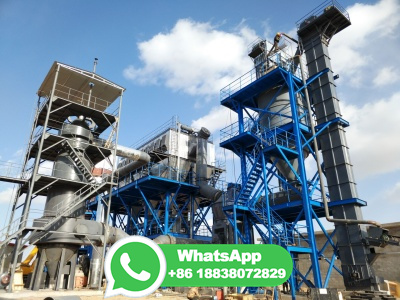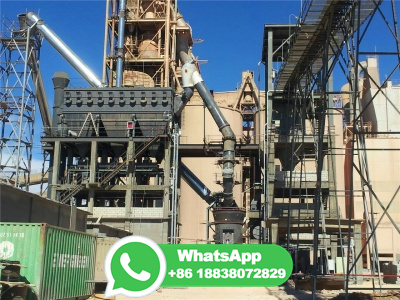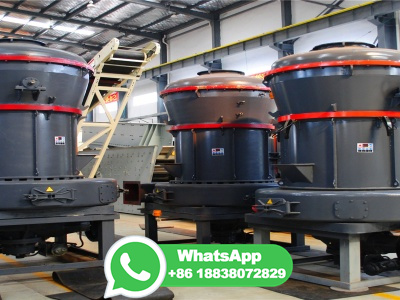
WEBJul 4, 2023 · Progress of the steel making process was measured by taking samples of the molten metal. When the steel quality meets the required carbon levels (below %), the oxygen blowing was stopped and the steel was tapped from EOF into a ladle. During this refining process, slag was removed intermittently.
WhatsApp: +86 18203695377
WEBFeb 1, 2009 · Ironmaking involves the separation of iron ores. It not only represents the first step in steelmaking but also is the most capitalintensive and energyintensive process in the production of steel. The main route for producing iron for steelmaking is to use the blast furnace, which uses metallurgical coke as the reductant. Concerns over the limited .
WhatsApp: +86 18203695377
WEBAbstract A mathematical model of the iron ore sintering process in a fixed sinter bed and optimisation of the process parameters using real valued genetic algorithm is described. The mathematical model is formulated based on mass and energy balances in gas and solid phases, which are represented by simple partial differential equations. The model .
WhatsApp: +86 18203695377
WEBDec 1, 2023 · The outputs of this process are iron and carbon dioxide. The basic oxygen furnace is then used to convert the iron into steel. As a global average, this method of steelmaking emits around ...
WhatsApp: +86 18203695377
WEBThe blast furnace ironmaking process is reduction melting, whose thermodynamic principle of metallurgical reaction is well understood. As the stock column going downside, carbon monoxide and hydrogen are gradually reduced from ferric iron to ferrous iron and then to metal by Fe 2 O 3 → Fe 3 O 4 → FeO → Fe at 400 °C. This reduction process of iron .
WhatsApp: +86 18203695377
WEBMar 8, 2021 · BFBOF route employs a blast furnace (BF) to reduce the iron ore to molten iron and subsequently refined to steel in a basic oxygen furnace (BOF). As the dominant technology for primary steelmaking, BFBOF route produced 71% of global crude steel production, over 1279 million tons in 2018 [(Worldsteel Association, 2019]].
WhatsApp: +86 18203695377
WEBMay 14, 2020 · In the last years, pelletizing has been playing an important role in iron ore mining and in iron production (iron making and direct reduction). Some factors have contributed to this fact as ...
WhatsApp: +86 18203695377
WEBSteelmaking is the method of developing steel from iron ore (usually haematite) and scrap. The impurities such as nitrogen, sulphur, silicon, phosphorus and excess carbon are separated out from the raw iron and alloying elements such as nickel, manganese, vanadium, molybdenum and chromium are added to impart different properties to steel.
WhatsApp: +86 18203695377
WEBAug 1, 2007 · The United States emitted 55 MMT CO 2 from iron and steel production in 2014 [Bains et al., 2017]. Pelletizing, sintering, and cokemaking emit ~20% of the total CO 2 in the BFBOF route and the BF ...
WhatsApp: +86 18203695377
WEBSteel Smelting, Alloying, Refining: In principle, steelmaking is a melting, purifying, and alloying process carried out at approximately 1,600° C (2,900° F) in molten conditions. Various chemical reactions are initiated, either in sequence or simultaneously, in order to arrive at specified chemical compositions and temperatures. Indeed, many of the .
WhatsApp: +86 18203695377
WEBJul 1, 2019 · During sintering, fine iron ore particles are mixed with a small amount of coal (5% by weight), and the mixture is then ignited (Peters, 1982).The process is driven by the decrease in surface energy (surface area) that causes the edge of the particles to fuse together (Fig. 1).The particles produced in this manner have a lower density than .
WhatsApp: +86 18203695377
WEBHowever, in the hydrogen reduction steelmaking process, the reduction reaction and melting reaction occur in a reduction furnace and electric furnace, respectively, not in a blast furnace. First, iron ore (Fe 2 O 3) contacts hydrogen heated to a high temperature to make iron (Fe). The iron made this way is called direct reduced iron (DRI).
WhatsApp: +86 18203695377
WEBOct 27, 2021 · The most promising hydrogenbased steelmaking route is the direct reduction of iron ore by pure H 2 followed by electric steelmaking. It indeed combines a certain technological maturity and very good performance in terms of emissions reduction (more than 85% decrease).
WhatsApp: +86 18203695377
WEBJul 11, 2018 · The iron ore production has significantly expanded in recent years, owing to increasing steel demands in developing countries. However, the content of iron in ore deposits has deteriorated and lowgrade iron ore has been processed. The fines resulting from the concentration process must be agglomerated for use in iron and steelmaking. .
WhatsApp: +86 18203695377
WEBMay 1, 2014 · 1. Introduction. Iron and steel manufacturing is one of the most energyintensive industries worldwide. In addition, use of coal as the primary fuel for iron and steel production means that iron and steel production has among the highest carbon dioxide (CO 2) emissions of any to the International Energy Agency (IEA), the .
WhatsApp: +86 18203695377
WEBAug 26, 2023 · The ironmaking process extracts crude metal from ore using coke as a reducing agent, while the steelmaking process removes excess elements and impurities to produce highquality steel. The production process has evolved to include multilevel operations and specialization of functional division. Solid waste generated during .
WhatsApp: +86 18203695377
WEBMar 3, 2020 · In the blast furnace process, ironbearing materials ( lumps iron ore, sinter/pellets, mill scale and steelmaking slag), coke (fuel as well as reducer) and flux (limestone and/or dolomite) are charged by the skip .
WhatsApp: +86 18203695377![[PDF] OPTIMIZATION OF STEELMAKING USING FASTMET DIRECT REDUCED IRON .](/3wa9brv/287.jpg)
WEBDec 15, 2013 · Steelmaking contributes by more than 5% to the world's anthropogenic CO2 emissions, so new ways to reduce the emissions in this industrial sector must be found. During a transition to more sustainable production concepts, also economic factors must be considered. In this paper the potential of using direct reduced iron (DRI) from .
WhatsApp: +86 18203695377
WEBJan 1, 2012 · A mathematical model of the iron ore sintering process in a fixed sinter bed and optimisation of the process parameters using real valued genetic algorithm is described. The mathematical model is ...
WhatsApp: +86 18203695377
WEBJan 1, 2013 · Steelmaking units should meet a number of requirements that could be classified into four groups in the following way: 1. Process requirements ensure the necessity to produce various steel grades of required quality. 2. Economic requirements call for reduction of manufacturing costs so as to increase profitability and competitiveness of ...
WhatsApp: +86 18203695377
WEBSep 25, 2020 · It is an alloy of iron and some other element such as chromium. Steel has been manufactured since ages, but the large scale commercialization of the process began only in the 19th century. The 1850s and 1860s saw the advent of different revolutionary techniques, turned the steelmaking process into a mainstream industry.
WhatsApp: +86 18203695377
WEBDec 3, 2020 · The impact of scrap steel on human health ranks third. Molten iron is a key process that affects human health, climate change, ecosystems quality, and resources. In addition, processes such as ...
WhatsApp: +86 18203695377